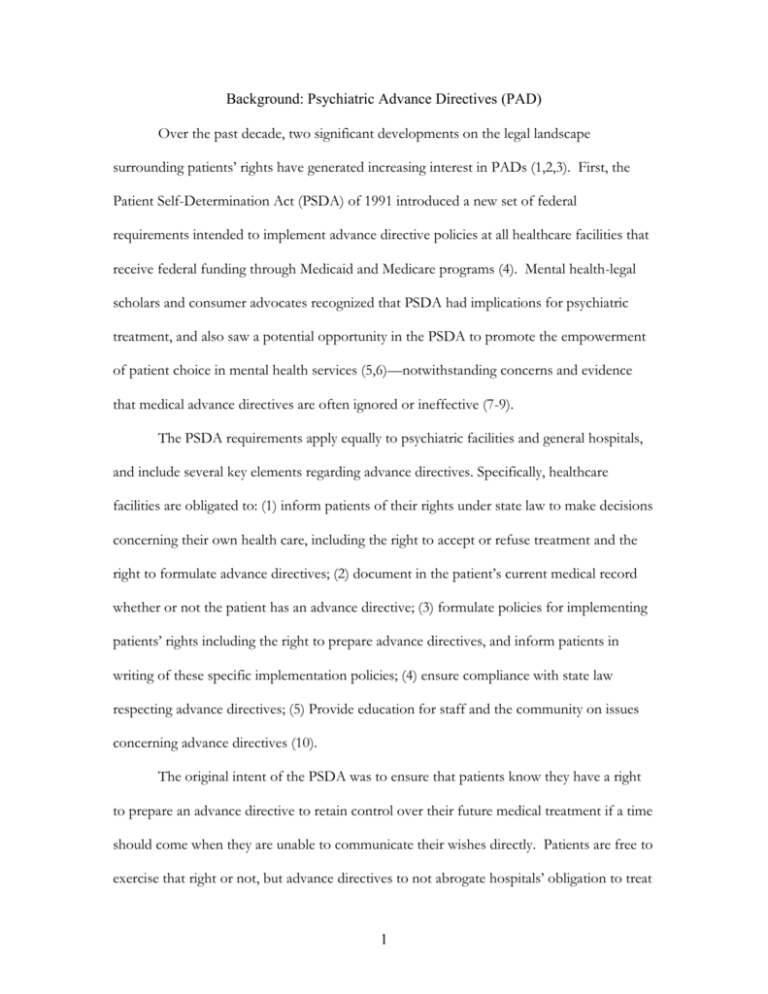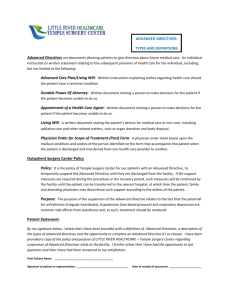Background: Psychiatric Advance Directives
advertisement

Background: Psychiatric Advance Directives (PAD) Over the past decade, two significant developments on the legal landscape surrounding patients’ rights have generated increasing interest in PADs (1,2,3). First, the Patient Self-Determination Act (PSDA) of 1991 introduced a new set of federal requirements intended to implement advance directive policies at all healthcare facilities that receive federal funding through Medicaid and Medicare programs (4). Mental health-legal scholars and consumer advocates recognized that PSDA had implications for psychiatric treatment, and also saw a potential opportunity in the PSDA to promote the empowerment of patient choice in mental health services (5,6)—notwithstanding concerns and evidence that medical advance directives are often ignored or ineffective (7-9). The PSDA requirements apply equally to psychiatric facilities and general hospitals, and include several key elements regarding advance directives. Specifically, healthcare facilities are obligated to: (1) inform patients of their rights under state law to make decisions concerning their own health care, including the right to accept or refuse treatment and the right to formulate advance directives; (2) document in the patient’s current medical record whether or not the patient has an advance directive; (3) formulate policies for implementing patients’ rights including the right to prepare advance directives, and inform patients in writing of these specific implementation policies; (4) ensure compliance with state law respecting advance directives; (5) Provide education for staff and the community on issues concerning advance directives (10). The original intent of the PSDA was to ensure that patients know they have a right to prepare an advance directive to retain control over their future medical treatment if a time should come when they are unable to communicate their wishes directly. Patients are free to exercise that right or not, but advance directives to not abrogate hospitals’ obligation to treat 1 patients according to appropriate standards of care and practice; at the same time, hospitals cannot use their obligation to treat patients appropriately as an excuse to override a patient’s advance directive. Potential conflicts may arise between healthcare providers’ perceived legal and ethical duties to provide the specific treatment that they believe is best for patients, and their obligation to abide by patients’ own wishes regarding acceptance of recommended treatment. Such conflict may become especially problematic in the case of individuals who suffer from severe psychiatric disorders, which may, at times, significantly impair judgment and the ability to recognize the gravity of one’s condition and need for intervention (11, 12). Whether advance directives for mental health treatment will prove to be a help or a hindrance in resolving such conflicts is a matter of current debate, supported by opinions but sparse empirical evidence on either side. Preliminary studies of opinions about PADs suggest that these instruments are promising, but much more definitive research is needed (13, 14). The second motivating force behind the rise of PADs in recent years has been the intense reaction, in some quarters, against policies of legally mandating psychiatric treatment (15)—particularly outpatient commitment policies (16, 17). Outpatient commitment has been criticized as offering a perverse choice between coercion and neglect. In contrast, PADs appear to offer a more positive alternative: the possibility of both patient empowerment and beneficial treatment. Might the deleterious pattern of fragmented, intermittent, and often involuntary treatment be changed by advance planning on the part of persons with mental illness themselves? In theory, a PAD—and the process of preparing a PAD while competent—could facilitate engagement in the treatment process, help to mobilize clinical resources as necessary, improve adherence with beneficial therapies, 2 facilitate communication between providers, caregivers and patients, and thus help to avert psychiatric crises or improve management of such crises without resort to involuntary commitment. (18, 13, 19-23). Based on the hope for these benefits, more and more state legislatures have adopted PAD statutes and authorized the advance appointment of proxy decisionmakers for persons with SMI who may anticipate loss of capacity during a mental health crisis. References 1 Appelbaum, P.S. (1991). Advance directives for mental health treatment. Hospital and Community Psychiatry, 42:983-984. 2 Winick, B.J. (1996). Advance directive instruments for those with mental illness. University of Miami Law Review 51 (1): 57-95. 3 Fleischner, R.D. (1998). An analysis of advance directive statutes and their application to mental health care and treatment. Prepared for the Advocacy Training/Technical Assistance Center (ATTAC) of the National Association of Protection & Advocacy Systems, Inc. (NAPAS). 4 Greco, P.J., Schulman, K.A., Lavizzo-Mourey, R., & Hansen-Flaschen, J. (1991). The Patient Self-determination Act and the future of advance directives. Annals of Internal Medicine, 115: 639-643. 5 Kapp, M. B. (1994). Implications of the Patient Self-Determination Act for psychiatric practice. Hospital & Community Psychiatry. 45(4) 355-358. 6 Hoge, S. K. (1994). The Patient Self-Determination Act and psychiatric care. Bulletin of the American Academy of Psychiatry & the Law. 22(4), 577-586. 7 Wolf, S.M. (1991). Sources of concern about the Patient Self-Determination Act. New England Journal of Medicine, 325:1666-1672. 3 8 Teno, J., Lynn, J., Wenger, N., Phillips, R.S. Murphy, D.P., Connors, A.F., Desbiens, N., Fulkerson, W., Bellamy, P., Knaus, W.A. (1997). Advance directives for seriously ill hospitalized patients: Effectiveness with the Patient Self-Determination Act and the SUPPORT intervention. Journal of the American Geriatrics Society, 45:500-507. 9 Howe, E.G. (2000). Lessons from advance directives for PADs: commentary on psychiatric advance directives: an alternative to coercive treatment. Psychiatry, 63 (2): 173-177. 10 United States Code (2000). Agreements with providers of services, Sec. 1395cc. In Title 42, The Public Health and Welfare, Chapter 7: Social Security; Subchapter XVIII: Health Insurance for Aged and Disabled, Part D: Miscellaneous Provisions, and Subchapter XIX: Grants to States for Medical Assistance Programs, Sec. 1396a: State plans for medical assistance (42 USC §§1395cc, 1396a). 11 Sales, G.N. (1993). The health care proxy for mental illness: Can it work and should we want it to?. Bulletin of the American Academy of Psychiatry & the Law, 21(2): 161-179. 12 Halpern, A. & Szmukler, G. (1997). Psychiatric advance directives: Reconciling autonomy and non-consensual treatment. Psychiatric Bulletin, 21:323-327. 13 Amering, M., Denk, E., Griengl, H., Sibitz, I., Stastny, P. (1999). Psychiatric wills of mental health professionals: a survey of opinions regarding advance directives in psychiatry. Social Psychiatry and Psychiatric Epidemiology, 34:30-34. 14 Backlar, P., McFarland, B., Swanson, J.W., Paulson, R., Mahler, J. (2001). Consumer, provider, and informal caregiver opinions on psychiatric advance directives. Administration and Policy in Mental Health, 28 (6):427-441. 4 15 Lefley, H.P. (1993). Involuntary treatment: concerns of consumers, families, and society. Innovations in Research, 2:7-9. 16 Swartz, M.S., Swanson, J.W. (2002). Involuntary Outpatient Commitment in the United States: Practice and Controversy. In Buchanan, Alec, Ed. Care for the Mentally Disordered Offender in the Community. Oxford: Oxford University Press. 17 Swanson, J.W., Tepper, M.C., Backlar, P.B., Swartz, M.S., Estroff, S.E. (2000). Psychiatric advance directives: An alternative to coercive treatment?” Psychiatry, 63 (2):160-172. 18 Srebnik, D.S., & La Fond, J.Q. (1999). Advance directives for mental health treatment. Psychiatric Services, 50 (7):919-925. 19 Stavis, P. F. (1999). The Nexum: a modest proposal for self-guardianship by contract: a system of advance directives and surrogate committees-at-large for the intermittently mentally ill. Journal of Contemporary Health Law & Policy, 16(1):195. 20 Backlar, P. (1995). The longing for order: Oregon’s Medical Advance Directive for Mental Health Treatment. Community Mental Health Journal, 31(2):103-108. 21 Backlar, P., & McFarland, B.H. (1996). A survey on use of advance directives for mental health treatment in Oregon. Psychiatric Services, 47(12):1387-1389. 22 Savulescu, J., & Dickensen, D. (1998). The time frame of preferences, dispositions, and the validity of advance directives for the mentally ill. Philosophy, Psychiatry, & Psychology, 5(3):225-246 and 263-266. 23 Brock, D.W. (1998). Commentary on "The time frame preferences, dispositions, and the validity of advance directives for the mentally ill." Philosophy, Psychiatry, & Psychology. Vol 5(3): 251-253. 5





